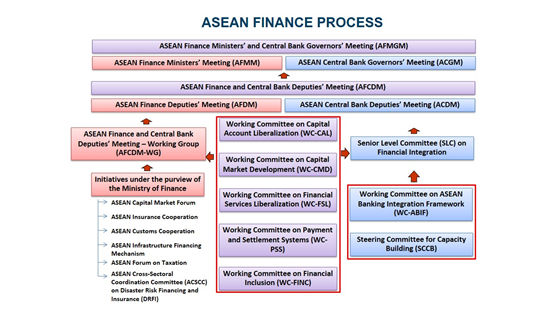Association of South-East Asian Nations (ASEAN)
The Ministry of Finance and the BOT are Thailand’s main representatives for financial cooperation and regional macroeconomic surveillance under the ASEAN Finance Ministers’ and Central Bank Governors Meeting (AFMGM). The BOT plays a role in promoting and driving financial integration and cooperation with 3 overarching objectives: Integration, Inclusion, and Stability.
Financial integration has been continuously developed through various Working Committees (see picture). The BOT is involved in the Working Committees on Capital Account Liberalization, Capital Market Development, Payment and Settlement Systems, Financial Inclusion, and Financial Services Liberalization, as well as the ASEAN Banking Integration Framework which facilitates access for member financial institutions under the Qualified ASEAN Bank (QAB) framework. QAB represents bilateral negotiations between member countries on a voluntary basis based on each members’ readiness. An example is the QAB arrangement between the BOT and Bank Negara Malaysia.

In 2019, Thailand was the ASEAN Chair under the theme “Advancing Partnership for Sustainability” with aimed for ASEAN to closely cooperate under the principle of ASEAN centrality which emphasizes mutual benefits and leaving no one behind. 3 key areas of focus included:
1) Connectivity: To support financial integration and promote increased financial services connectivity so that the private sector can carry out financial transactions more efficiently. The BOT implemented key strategies such as promoting local currency usage and cross-border payments between member countries.
2) Sustainability: To support various financial institutions and financial instruments that act as financial intermediaries in allocating capital to businesses with a focus on sustainability and social growth rather than short term benefits. The BOT puts forth Sustainable Finance as a primary agenda for ASEAN and elevated awareness on Sustainable Banking.
3) Resilience: To promote regional financial stability and safety, the BOT will emphasize financial cyber security framework so that ASEAN member countries have an efficient cyber data exchange framework, as well as develop cybersecurity knowledge for financial personnel in ASEAN member countries.
Additional Information
International Cooperation Team 1-2, International Cooperation Department, Corporate Relations Group
E-mail: IND-Cooperation@bot.or.th